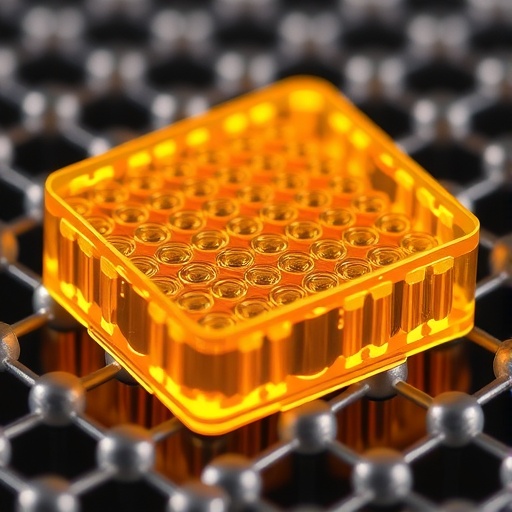Researchers have made a groundbreaking discovery in the realm of energy storage technologies, focusing on the synthesis and application of nitrogen-rich C₃N₅ nanosheets. This innovative material is being touted for its potential use as an electrode in high-performance supercapacitors. Scientists have long sought ways to enhance the efficiency, energy density, and longevity of supercapacitors, which are crucial for various applications ranging from consumer electronics to electric vehicles and renewable energy systems. The remarkable properties of C₃N₅ nanosheets present a promising avenue for achieving these goals.
The intrinsic properties of nitrogen-rich materials have long piqued the interest of material scientists. Nitrogen, being a non-metal, contributes to the electronic structure of materials and significantly influences their electrochemical performance. The unique configuration of the C₃N₅ molecular structure allows for improved charge storage capabilities, making it an ideal candidate for next-generation energy storage solutions. The integration of nitrogen within the carbon framework enhances conductivity and stability, thus providing a pathway to superior supercapacitor performance.
The synthesis of C₃N₅ nanosheets is a meticulous process that involves controlled chemical reactions to ensure the formation of a stable yet reactive nanosheet structure. Through advanced techniques such as chemical vapor deposition and other novel methodologies, researchers have successfully created these nanosheets with exceptional surface area and porosity. These properties are essential for maximizing the interaction between the electrode material and the electrolyte, thereby boosting the overall energy storage capacity of supercapacitors.
.adsslot_aYALbPBDWZ{ width:728px !important; height:90px !important; }
@media (max-width:1199px) { .adsslot_aYALbPBDWZ{ width:468px !important; height:60px !important; } }
@media (max-width:767px) { .adsslot_aYALbPBDWZ{ width:320px !important; height:50px !important; } }
ADVERTISEMENT
When it comes to energy density, supercapacitors have always been seen as a bridge between traditional capacitors and batteries. However, the conventional materials used, such as activated carbon, often fall short in providing optimal performance. The introduction of C₃N₅ nanosheets offers a significant edge, as they exhibit higher specific capacitance values. This enhancement allows for greater energy storage within the same physical footprint, making them ideal for compact energy storage systems where space is at a premium.
In addition to their superior energy density, the electrochemical stability of C₃N₅ nanosheets sets them apart from other materials. Supercapacitors require materials that can endure numerous charge-discharge cycles without significant degradation. Research indicates that C₃N₅ nanosheets maintain structural integrity over extended use, showcasing their potential for long-term applications in various fields. This durability is particularly beneficial in applications where reliability is paramount, such as in electric vehicles and grid energy storage systems.
The versatility of C₃N₅ nanosheets extends beyond their application in supercapacitors. Their unique electronic structure and thermal properties may open doors to other energy storage devices, including batteries and fuel cells. This adaptability to different electrochemical environments allows for the potential development of hybrid systems that could enhance efficiency and performance in energy storage and conversion technologies.
Moreover, the environmental aspect of synthesizing C₃N₅ nanosheets represents a critical consideration as the world shifts towards sustainable energy solutions. Researchers have aimed to develop methods that not only yield high-performance materials but do so with minimal environmental impact. By leveraging green chemistry principles and optimizing synthesis routes, the lifecycle assessment of these materials reflects a responsible approach to advanced material development.
Efforts are underway to further optimize the performance parameters of C₃N₅ nanosheets. Researchers are exploring various doping strategies and composite materials that could enhance conductivity and energy storage capacity even further. By fine-tuning the nanosheet composition and structure, scientists aim to push the boundaries of what is achievable with supercapacitor technology. The goal is to create electrodes that can not only store more energy but also deliver rapid charging and discharging capabilities for real-time applications.
As the race for next-generation energy storage solutions accelerates, the academic and industrial communities are keenly observing the advancements in C₃N₅ nanosheet technology. Collaborations between universities and research institutions are fostering an environment rich in innovation, paving the way for practical applications of this material. Industry leaders are also recognizing the potential of these nanosheets, which could revolutionize the way energy is stored and utilized in the future.
The implications of C₃N₅ nanosheets extend beyond simple technological advancements. This research can influence policy decisions regarding energy storage and sustainability goals across various sectors. As countries aim to transition to cleaner energy systems, the role of advanced materials in enabling such transitions cannot be underestimated. In fact, the development of high-performance supercapacitors using C₃N₅ nanosheets could play a significant role in achieving national and global energy targets.
Moreover, the anticipated commercialization of C₃N₅ nanosheet technology could drive economic growth in the green technology sector. The manufacture and application of such advanced materials are likely to generate new job opportunities and spur interest in further research and development. There is a genuine enthusiasm in the market for innovative energy storage solutions, and C₃N₅ nanosheets could well become a cornerstone of this emerging landscape.
In summary, the research surrounding nitrogen-rich C₃N₅ nanosheets highlights a pivotal moment in energy storage innovation. The advantages they offer in terms of efficiency, stability, and sustainability position them as a leading candidate for next-generation supercapacitors and other energy applications. As this field of study matures, architects of the energy future must harness the potential of such innovative materials to reshape the world’s energy landscape for generations to come.
Subject of Research: Nitrogen-rich C₃N₅ nanosheets for supercapacitors
Article Title: Tailoring nitrogen-rich C₃N₅ nanosheets as a potential electrode material for high-performance supercapacitor
Article References:
Subbiah, M., Muthusamy, K., Sundaramurthy, A. et al. Tailoring nitrogen-rich C₃N₅ nanosheets as a potential electrode material for high-performance supercapacitor. Ionics (2025). https://doi.org/10.1007/s11581-025-06587-5
Image Credits: AI Generated
DOI: https://doi.org/10.1007/s11581-025-06587-5
Keywords: Energy storage, supercapacitors, C₃N₅ nanosheets, nitrogen-rich materials, electrochemical performance, sustainability, advanced materials.
Tags: advanced material synthesis techniquesC3N5 nanosheetscharge storage capabilities improvementelectrochemical performance enhancementelectronic structure of nitrogen materialshigh-performance supercapacitorsinnovative energy technologiesnitrogen-rich energy storage materialsrenewable energy applicationsstability and conductivity in electrodessupercapacitor electrode optimizationsustainable energy storage solutions





